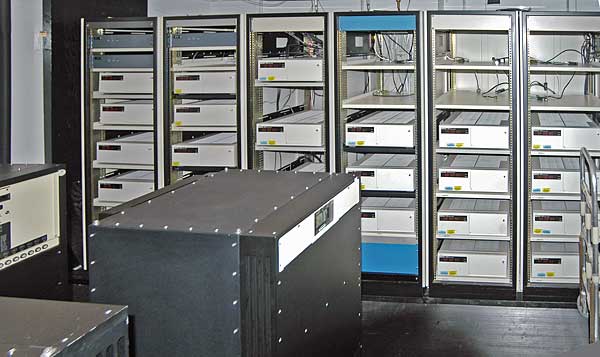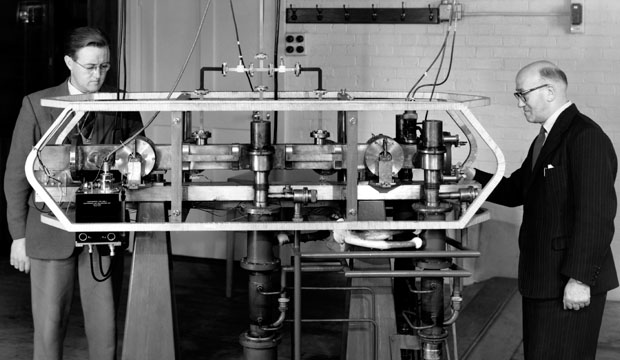|
Magic Wavelength
The magic wavelength (also known as a related quantity, magic frequency) is the wavelength of an optical lattice where the polarizabilities of two atomic clock states have the same value, such that the AC Stark shift caused by the laser intensity fluctuation has no effect on the transition frequency between the two clock states. AC Stark shift by optical lattice The laser field in an optical lattice induces an electric dipole moment in the atoms to exert forces on them and hence confine them. However, the difference in polarizabilities of the atomic states leads to an AC Stark shift in the transition frequency between the two states, a shift that is dependent on the laser optical intensity at the particular atom location in the lattice. When it comes to precise measurements of transition frequency such as atomic clocks, the temporal fluctuations of the laser optical intensity would then deteriorate the clock accuracy. Furthermore, due to the spatial variation of laser intensity ... [...More Info...] [...Related Items...] OR: [Wikipedia] [Google] [Baidu] |
Optical Lattice
An optical lattice is formed by the interference of counter-propagating laser beams, creating a spatially periodic polarization pattern. The resulting periodic potential may trap neutral atoms via the Stark shift. Atoms are cooled and congregate at the potential extrema (at maxima for blue-detuned lattices, and minima for red-detuned lattices). The resulting arrangement of trapped atoms resembles a crystal lattice and can be used for quantum simulation. Atoms trapped in the optical lattice may move due to quantum tunneling, even if the potential well depth of the lattice points exceeds the kinetic energy of the atoms, which is similar to the electrons in a conductor. However, a superfluid– Mott insulator transition may occur, if the interaction energy between the atoms becomes larger than the hopping energy when the well depth is very large. In the Mott insulator phase, atoms will be trapped in the potential minima and cannot move freely, which is similar to the electron ... [...More Info...] [...Related Items...] OR: [Wikipedia] [Google] [Baidu] |
Polarizability
Polarizability usually refers to the tendency of matter, when subjected to an electric field, to acquire an electric dipole moment in proportion to that applied field. It is a property of all matter, considering that matter is made up of elementary particles which have an electric charge, namely protons and electrons. When subject to an electric field, the negatively charged electrons and positively charged atomic nuclei are subject to opposite forces and undergo charge separation. Polarizability is responsible for a material's dielectric constant and, at high (optical) frequencies, its refractive index. The polarizability of an atom or molecule is defined as the ratio of its induced dipole moment to the local electric field; in a crystalline solid, one considers the dipole moment per unit cell. Note that the local electric field seen by a molecule is generally different from the macroscopic electric field that would be measured externally. This discrepancy is taken into account by ... [...More Info...] [...Related Items...] OR: [Wikipedia] [Google] [Baidu] |
Atomic Clock
An atomic clock is a clock that measures time by monitoring the resonant frequency of atoms. It is based on atoms having different energy levels. Electron states in an atom are associated with different energy levels, and in transitions between such states they interact with a very specific frequency of electromagnetic radiation. This phenomenon serves as the basis for the International System of Units' (SI) definition of a second:The second, symbol s, is the SI unit of time. It is defined by taking the fixed numerical value of the caesium frequency, \Delta \nu_\mathsf, the unperturbed ground-state hyperfine transition frequency of the caesium 133 atom, to be when expressed in the unit Hz, which is equal to s−1. This definition is the basis for the system of International Atomic Time (TAI), which is maintained by an ensemble of atomic clocks around the world. The system of Coordinated Universal Time (UTC) that is the basis of civil time implements leap seconds to allo ... [...More Info...] [...Related Items...] OR: [Wikipedia] [Google] [Baidu] |
Stark Effect
The Stark effect is the shifting and splitting of spectral lines of atoms and molecules due to the presence of an external electric field. It is the electric-field analogue of the Zeeman effect, where a spectral line is split into several components due to the presence of the magnetic field. Although initially coined for the static case, it is also used in the wider context to describe the effect of time-dependent electric fields. In particular, the Stark effect is responsible for the pressure broadening (Stark broadening) of spectral lines by charged particles in plasmas. For most spectral lines, the Stark effect is either linear (proportional to the applied electric field) or quadratic with a high accuracy. The Stark effect can be observed both for emission and absorption lines. The latter is sometimes called the inverse Stark effect, but this term is no longer used in the modern literature. History The effect is named after the German physicist Johannes Stark, who discov ... [...More Info...] [...Related Items...] OR: [Wikipedia] [Google] [Baidu] |
Intensity (physics)
In physics, the intensity or flux of radiant energy is the power transferred per unit area, where the area is measured on the plane perpendicular to the direction of propagation of the energy. In the SI system, it has units watts per square metre (W/m2), or kg⋅ s−3 in base units. Intensity is used most frequently with waves such as acoustic waves (sound) or electromagnetic waves such as light or radio waves, in which case the ''average'' power transfer over one period of the wave is used. ''Intensity'' can be applied to other circumstances where energy is transferred. For example, one could calculate the intensity of the kinetic energy carried by drops of water from a garden sprinkler. The word "intensity" as used here is not synonymous with " strength", "amplitude", " magnitude", or " level", as it sometimes is in colloquial speech. Intensity can be found by taking the energy density (energy per unit volume) at a point in space and multiplying it by the velocity at ... [...More Info...] [...Related Items...] OR: [Wikipedia] [Google] [Baidu] |
Hyperfine Structure
In atomic physics, hyperfine structure is defined by small shifts in otherwise degenerate energy levels and the resulting splittings in those energy levels of atoms, molecules, and ions, due to electromagnetic multipole interaction between the nucleus and electron clouds. In atoms, hyperfine structure arises from the energy of the nuclear magnetic dipole moment interacting with the magnetic field generated by the electrons and the energy of the nuclear electric quadrupole moment in the electric field gradient due to the distribution of charge within the atom. Molecular hyperfine structure is generally dominated by these two effects, but also includes the energy associated with the interaction between the magnetic moments associated with different magnetic nuclei in a molecule, as well as between the nuclear magnetic moments and the magnetic field generated by the rotation of the molecule. Hyperfine structure contrasts with '' fine structure'', which results from the interact ... [...More Info...] [...Related Items...] OR: [Wikipedia] [Google] [Baidu] |
Electric Dipole Moment
The electric dipole moment is a measure of the separation of positive and negative electrical charges within a system, that is, a measure of the system's overall polarity. The SI unit for electric dipole moment is the coulomb-meter (C⋅m). The debye (D) is another unit of measurement used in atomic physics and chemistry. Theoretically, an electric dipole is defined by the first-order term of the multipole expansion; it consists of two equal and opposite charges that are infinitesimally close together, although real dipoles have separated charge.Many theorists predict elementary particles can have very tiny electric dipole moments, possibly without separated charge. Such large dipoles make no difference to everyday physics, and have not yet been observed. (See electron electric dipole moment). However, when making measurements at a distance much larger than the charge separation, the dipole gives a good approximation of the actual electric field. The dipole is represented by a ... [...More Info...] [...Related Items...] OR: [Wikipedia] [Google] [Baidu] |
Hidetoshi Katori
, is a Japanese physicist and professor at the University of Tokyo best known for having invented the magic wavelength technique for ultra precise optical lattice atomic clocks. Since 2011, Katori is also Chief Scientist at the Quantum Metrology Lab, RIKEN. Recently, Katori's group performed a measurement of gravitational redshift with two transportable strontium optical lattice clocks over nearly the entire height of the Tokyo Skytree, setting a new record for the best ground-based test of general relativity. Recognition *2005 – Award of Japan Society for the Promotion of Science *2005 – Springer Nature Applied Physics Award *2006 – Japan IBM Science Prize *2008 – I. I. Rabi Award *2010 – Ichimura Academic Award *2011 – Award of Minister of MEXT *2011 – Philipp Franz von Siebold-Preis, Germany *2012 – Asahi Prize *2013 – Nishina Memorial Prize *2013 – Fujiwara Prize Fujiwara (, written: 藤原 lit. "'' Wisteria'' field") is a Japanese surname. ... [...More Info...] [...Related Items...] OR: [Wikipedia] [Google] [Baidu] |
Physical Quantities
A physical quantity is a physical property of a material or system that can be quantified by measurement. A physical quantity can be expressed as a ''value'', which is the algebraic multiplication of a ' Numerical value ' and a ' Unit '. For example, the physical quantity of mass can be quantified as '32.3 kg ', where '32.3' is the numerical value and 'kg' is the Unit. A physical quantity possesses at least two characteristics in common. # Numerical magnitude. # Units Symbols and nomenclature International recommendations for the use of symbols for quantities are set out in ISO/IEC 80000, the IUPAP red book and the IUPAC green book. For example, the recommended symbol for the physical quantity ''mass'' is ''m'', and the recommended symbol for the quantity ''electric charge'' is ''Q''. Subscripts and indices Subscripts are used for two reasons, to simply attach a name to the quantity or associate it with another quantity, or index a specific component (e.g., row or co ... [...More Info...] [...Related Items...] OR: [Wikipedia] [Google] [Baidu] |
Atomic Clocks
An atomic clock is a clock that measures time by monitoring the resonant frequency of atoms. It is based on atoms having different energy levels. Electron states in an atom are associated with different energy levels, and in transitions between such states they interact with a very specific frequency of electromagnetic radiation. This phenomenon serves as the basis for the International System of Units' (SI) definition of a second:The second, symbol s, is the SI unit of time. It is defined by taking the fixed numerical value of the caesium frequency, \Delta \nu_\mathsf, the unperturbed ground-state hyperfine transition frequency of the caesium 133 atom, to be when expressed in the unit Hz, which is equal to s−1. This definition is the basis for the system of International Atomic Time (TAI), which is maintained by an ensemble of atomic clocks around the world. The system of Coordinated Universal Time (UTC) that is the basis of civil time implements leap seconds to allow c ... [...More Info...] [...Related Items...] OR: [Wikipedia] [Google] [Baidu] |


